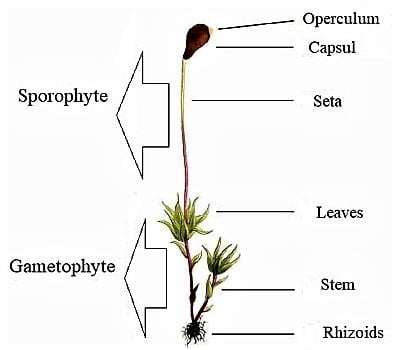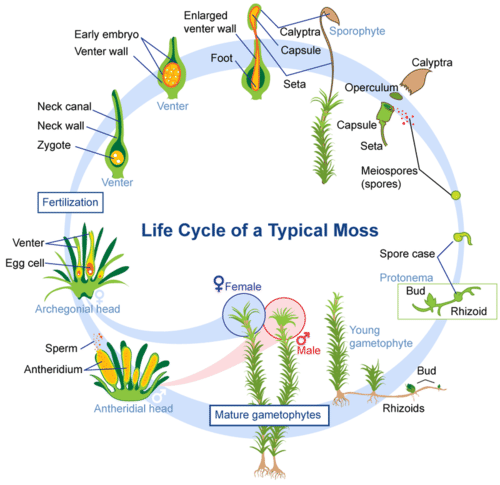Life Cycle of Nonvascular Plants Study Guide
Introduction
Nonvascular plants, or Bryophytes, are known as gametophyte dominant plants. They are defined as those plants that do not have any vascular tissue which transports water and nutrients to the other parts of the plant body. Or in other words, they do not have any xylem or phloem. They include plants like mosses, hornworts, and liverworts. Since there are no differentiated tissues, they are low-lying plants normally found in wet habitats.
Nonvascular Plants Reproduction
Nonvascular plants alternate between the asexual and sexual stages within their life cycles. This is called “Alternation of Generations”, or Metagenesis of Heterogenesis.
-
Sexual Reproduction is brought about by the production of male and female gametes and is known as the gametophyte life cycle phase.
-
Asexual Reproduction is brought about by the production of spores and is known as the sporophyte phase.
Another important characteristic is the male sperms of nonvascular plants have two flagella for movement. The gametophyte stage looks like a leafy green growth attached to some moist substrate. The production of spores characterizes the sporophyte stage. The sporophyte protrudes from the body of the gametophyte and looks like a long stalk having a cap at the top end and containing the spores.
The green gametophyte is the site of photosynthesis, and so the sporophyte is totally dependent upon the gametophyte for its growth and nutrition. Hence the gametophyte life cycle is the dominant phase in the entire life cycle of nonvascular plants. Until a suitable condition arises, the sporophyte generation is not initiated.
Nonvascular Plant Life Cycle
There is an alternation of two generations in the moss life cycle: the Gametophyte and the Sporophyte.
Starting with the Sporophyte Phase, the plant’s diploid sporophytes produce haploid spores which are contained within capsules present at the tips of long stalk-like structures called Seta. Such spores contain cells capable of undergoing meiosis, the process by which the genetic material within the spores gets divided. Hence, the spores created by the sporophyte are haploid.
The capsules only open up when a lid-like structure called the Operculum degenerates. The spores are then released from the capsules into the surrounding environment upon maturation. The wind scatters them, and when they settle on a suitable substratum with ideal amounts of moisture and sunlight, they germinate and develop into branched filamentous structures called Protonema, which develop into the gametophores.
A Gametophore appears as a leafy plant-like structure that later matures into a Gametophyte. Gametophytes are either male or female structures depending on their sex organs. Antheridia are the male sex organs that produce the sperms, and Archegonia are the female sex organs that produce the eggs.
Both the sperms and eggs are called gametes and are haploid, which means they contain only one set of DNA. The gametes are produced by mitosis. The sperms swim towards the egg in wet conditions and fertilize it to give rise to the diploid Zygote. The zygote then develops and matures into a sporophyte, and the cycle repeats.
✅ Conclusion
-
While all nonvascular plants reproduce by the sporophyte gametophyte life cycle, liverworts can also reproduce by fragmentation.
-
A new plant can develop from an existing piece of liverwort when it breaks off.
-
Gemmae formation is another type of asexual reproduction in liverworts in which there are cells attached to plant surfaces that can grow into new plants when they are detached.
-
The sporophytes in hornworts are shaped like horns and possess cells called “pseudo-elaters,” which help in dispersing the spores.
FAQs
2. What are the two stages of life for nonvascular plants called?
The two stages in the life cycle of nonvascular plants are called the gametophyte phase and the sporophyte phase.
1. What is the first stage in the life cycle of a nonvascular plant?
The first stage in the life cycle of nonvascular plants is the sporophyte phase, in which spores are released from the capsule-shaped structures present at the tips of the seta.
3. What is the reproductive cycle of nonvascular plants called?
The reproductive cycle of nonvascular plants is called the alternation of generations or heterogenesis or metagenesis.
4. How is the life cycle of seedless vascular plants different from that of nonvascular plants?
The gametophyte phase is the dominant stage in the life cycle of nonvascular plants, while the sporophyte phase is the dominant stage in the seedless vascular plants’ life cycle.
5. Which life cycle phase follows the gametophyte phase in nonvascular plants?
The sporophyte phase follows the gametophyte phase in the life cycle of nonvascular plants.
6. How do nonvascular plants and seedless vascular plants reproduce?
Nonvascular plants and seedless vascular plants both reproduce by sexual means in which there is the production of male and female gametes, and asexual means in which there is a production of spores by the sporophytes.
7. What are the differences between nonvascular and seedless vascular plants?
Nonvascular plants do not have vascular tissues like xylem and phloem, while vascular seedless plants do. Nonvascular plants have a dominant gametophyte phase, but vascular seedless plants have a dominant sporophyte phase. Examples of nonvascular plants incle mosses, hornworts, and liverworts, and examples of seedless vascular plants include ferns, whisk ferns, club mosses, and horsetails.
8. How do nonvascular plants obtain water and nutrients?
Nonvascular plants do not possess any special organs for the absorption and transport of water; instead, the plant cells absorb water and nutrients from their wet surroundings at their surface by diffusion and pass them from cell to cell.
9. How do the life cycles of mosses and gymnosperms differ?
Mosses are nonvascular plants, while gymnosperms are vascular plants. Mosses have a dominant gametophyte phase in their life cycle, but the gymnosperms have a dominant seed phase.
10. How do the life cycle of endless plants and seed plants differ in what fundamental ways are they alike?
The seed-bearing plants produce seeds for propagation, while the seedless plants produce spores for propagation. Seedless plants produce spores via asexual reproduction, while seed-bearing plants produce seeds by sexual reproduction. Both the seedless and seed plants need water, carbon dioxide, and sunlight to survive, and both have vascular tissues.
We hope you enjoyed studying this lesson and learned something cool about the Life Cycle of Nonvascular Plants! Join our Discord community to get any questions you may have answered and to engage with other students just like you! Don’t forget to download our App to experience our fun, VR classrooms – we promise, it makes studying much more fun! 😎
Sources
-
Non-vascular plants. https://projects.ncsu.edu/project/bio181de/Lab/plant_phylogeny/non-vascular.html. Accessed 10 Dec, 2021.
-
What Is the Function of Seeds and Spores in Plants?. https://www.gardenguides.com/131140-function-seeds-spores-plants.html. Accessed 10 Dec, 2021.
-
Nonvascular Plants. https://flexbooks.ck12.org/cbook/ck-12-biology-flexbook-2.0/section/9.7/primary/lesson/nonvascular-plants-bio/. Accessed 10 Dec, 2021.
-
Nonvascular Plant. https://biologydictionary.net/nonvascular-plant/. Accessed 10 Dec, 2021.


